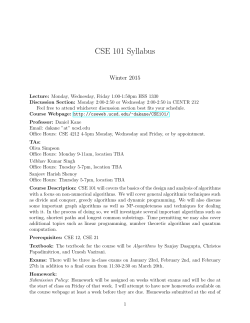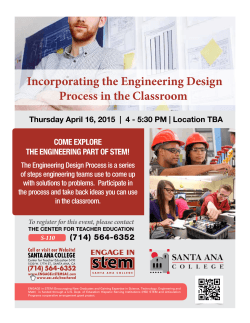
Courses in winter semester 2015/2016
COURSES IN ENGLISH AT THE FACULTY OF MATHEMATICS AND COMPUTER SCIENCE UNIVERSITY OF LODZ WINTER SEMESTER 2015/2016 REMARK: A course will be open for Erasmus or Mobility Direct students who choose at least 3 courses at the Faculty of Mathematics and Computer Science. Otherwise, a course can be open for at least 15 students. No. COURSE FORM ECTS USOS CODE D 5 1100-AX0UMM TBA 2. Algebra and Number Theory L/D 6 1100-EA0ENG TBA 3. Logic with Elements of Set Theory L/D 4 1100-LS0ENG TBA 4. It Work Environment LAB 4 1100-IT0ENG TBA 1. Analysis of Mathematical Texts LECTURER(S) SHORT DESCRIPTION The main goal of the course is ability of reading the maths texts, editing of the short maths texts and their presentation. The goal of the course is to present the notions of number theory and abstract algebra which are necessary for the understanding of the modern applications of those branches of mathematics in computer science, e.g., in cryptography. The aim of the subject is to acquaint students with the basic notions and methods of logic and the set theory, focusing on precise formulating of thought and acquiring the skill of proper reasoning. The main aim of the course is to familiarize students with various basic information technologies (UNIX, LaTeX, HTML, PHP, MySQL). 1 5. Introduction to Computer Science L/D 6 1100-IC0ENG TBA 6. Introduction to Programming L/ LAB 6 1100-PI0ENG TBA 7. Algorithms and Complexity L/ LAB 5 1100-AC0ENG TBA L/D 6 1100-DM0ENG TBA L/ LAB 5 1100-OP0ENG TBA 8. Discrete Mathematics 9. Object-Oriented Programming The course is a basic introduction to the most important computer science ideas and concepts. Topics vary from short historical background of computer science, through data representation, logic circuit design to programming languages, operating system concepts and computer networks. During the tutorials students acquire skills in using different numeral systems, boolean formula transformation, different data (e.g. numbers or images) representation methods. The emphasis is placed on learning how to describe algorithms and how to use them to solve given problem. A special attention is paid to adapt knowledge for a specific problem (student has to justify his/her choice, give appropriate example etc.) The aim of the course is to acquaint the students with the basics of programming in high-level programming languages (using a one chosen). The topics covered by the course are basic notions and structures used in programming (variables, data types, statements, input/output procedures, subprograms), as well as preparing programs which apply the above elements (together with developing algorithms to solve the problems) and analysing their correntness. The goal is to make students familiar with the methods of design and analysing algorithms. Topics connected with the notion of computational complexity, basic algorithms and data structures will be presented. The aim of the course is to teach the students foundations of discrete mathematics together with their applications. The aim of the subject is to acquaintance students with the object programming paradigm. They will learn the good practice of programming and object programming and the ability to abstract and save problems in the programming language. The lecture includes presentation of the methods of creating dynamic data structures. 2 10. Introduction to Databases L/ LAB 6 1100-ID0ENG TBA 11. Computer Graphics (IGL) L/ LAB 6 1100-CG0LEU TBA LAB 5 1100-CC0UII TBA 13. Artificial Intelligence L/ LAB 6 1100-AI0UEN TBA 14. Algorithmic Techniques L/ LAB 5 1100-AT0UEN TBA 12. Computer Aided Calculations The course familiarizes with basic concepts of database management systems. It focuses on relational model, relational algebra, and SQL (the standard language for creating, querying, and modifying relational databases). It also covers many aspects of database design using EntityRelationship-Model. The software used in this course is Oracle 10g and Oracle Data Modeler. The aim of the lecture is a presentation of theoretical basics of computer graphic without implementation details, presentation the most important algorithms in 2D and 3D graphics. The main aim of these classes is to familiarize students with well known and the most common numerical operations using MATLAB software. These skills will be crucial in their future professional career in any areas related to the research and development (R&D). The lecture includes the most important problems concerning artificial intelligence such as: fundamental methods and algorithms of artificial intelligence, fundamental information about neural networks as well as fuzzy logic. The aim of the computer laboratory is to implement selected algorithms presented during the lecture and to solve artificial intelligence problems. The goal is to make students familiar with the methods of design and analyzing algorithms. Topics connected with the notion of computational complexity, basic algorithms and data structures will be presented. During the workshop we will present advanced algorithms and data structures, on issues such as: efficient implementations of dictionaries, complex data structures, compression, graph algorithms, pattern matching algorithms, parallel algorithms, NP-completeness problems. 3 15. Modelling and Analysis of Computer Systems L/ LAB 5 1100-MA0UEN TBA LAB 6 1100-TP0UEN TBA 17. Programming Web Services L/ LAB 5 1100-PU0UEN TBA 18. IT Projects Management L/ LAB 6 1100-ZP0UEN TBA 16. Advanced Programming Techniques The primary objective of the lectures is to present the rules for creating information systems, with particular emphasis on the stages of analysis and modeling. The following issues will be discussed: analysis of the specific characteristics of information systems; acquainted with the methods of modeling enterprise information architecture; acquainted with the chosen modeling methods of organization and systems and related with them artifacts; acquainted with selected techniques analysis of systems and related with them artifacts. The objective is the acquisition of laboratory skills in the construction of models in the selected area of computer science and skillful handling of them. The main goal of the course is to develop the skills of object oriented programming using advanced techniques, design patterns, libraries and multithreading. During the course we shall introduce unit testing methodologies and application tracing techniques. The course aims to familiarize students with the methodology of concurrent and network application development, with particular emphasis on applications running on the internet. The course aims to acquaint the students with the classical and agile methodologies of project management and also with systematic approach to developing software products. Course will consider methods of analysis of potential projects and breaking tasks into smaller pieces. Moreover roles in the project and communication in the group and between project manager and project board will be presented. Techniques of measuring quality of the work, making contingency plans and immediate actions will be discussed. Also students will be acquainted with documentation templates. Laboratories aims to practice presented techniques with the students gathered in the project groups. 4 19. Machine-Language Programming L/ LAB 6 1100-JW0UEN TBA The aim of the course is to provide specific low-level programming including applications that are used in programming languages and presenting internal methods and algorithms for language-specific interior and the relation between these methods and the architecture of the computer system. Computer lab is the practical implementation of methods and algorithms for language specific example of internal architecture and x86 MASM assembly language and software development based on the combination of modules created in high-level and internal languages. Abbreviations: L – lecture; D – discussion class; LAB – Information technology laboratory TBA – to be announced 5
© Copyright 2025









